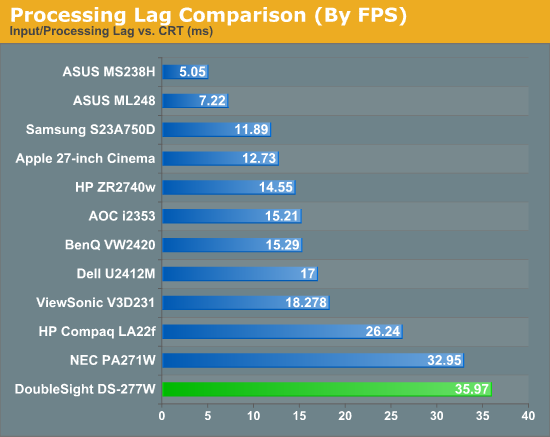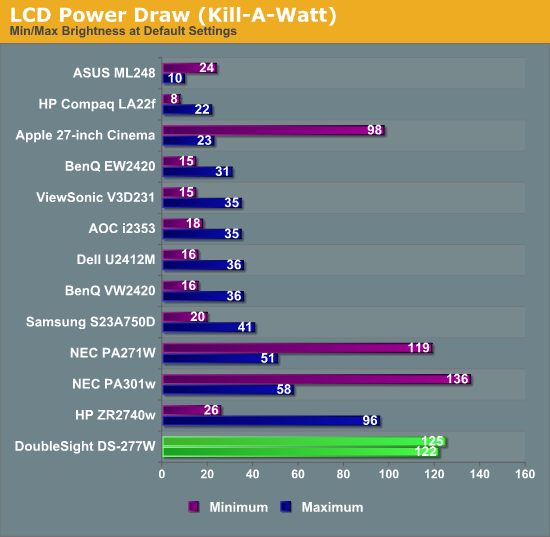DoubleSight DS-277W: Back to the Drawing Board
by Chris Heinonen on June 13, 2012 1:30 AM ESTSince all LCD displays have to be compared to a CRT display to calculate the lag, all of the testing is done at 1920x1080 resolution to keep the aspect ratio constant on the DS-277W. This might introduce a bit of an input delay, but because we use SMTT now to test displays we can separate input lag from pixel response to be more accurate.
Using SMTT, the DS-277W exhibited right around 21.3ms of input lag, and it took a full 29.3ms for a pixel to switch colors and come back, and combined this gives us an average response time of 36ms. This is over two frames of delay, so for many people this will not be an acceptable number for heavy gaming. Since the HP ZR2740w offers far faster pixel response time, and costs less to boot, that would be the 27” display I would still recommend with gaming in mind.

The DS-277W ships with an external power brick, and it seems to draw full current, all the time. At minimum brightness it was using 122 watts and at maximum it was drawing 125. Running at lower brightness to save on your energy bill isn’t a concern here, as the DS-277W is going to use a lot of power no matter how you have it setup.

I also tried to test out the DS-277W as a video display, since it has many inputs to use for this. Using an Oppo BDP-93 Blu-ray player, my first discovery was that in 1:1 mapping mode, it crops pixels from an HDMI signal. Losing 11 pixels on each side and 5 on the top and bottom, this is around 1% of overscan in effect, and there is really no reason for this at all. I did test using a PLUGE pattern from the Blu-ray player and found that the brightness control behaved the same over the HDMI input, controlling the black level as you’d expect on a TV.
Testing component didn’t even get that far. Once again using the Oppo player, which has a near perfect component video output, I couldn’t get an image on the screen at all. Using the Oppo BDP-83SE player instead also resulted in no image, so either the component video on my test LCD didn’t work correctly, or it didn’t like the timing of the Oppo players, or something else is just incorrect with the component video. Needless to say I wasn’t happy with the video testing results.











55 Comments
View All Comments
semo - Wednesday, June 13, 2012 - link
You guys need to concentrate a lot more on monitors that have DP. There must be plenty of budget displays out there with DP so why do you keep choosing the ones without!SteveTheWalrus - Wednesday, June 13, 2012 - link
this one was supposed to, but didn't...and why should they focus on DP anyways, at least for now its not very common.
mczak - Wednesday, June 13, 2012 - link
This monitor has 4 inputs, but only one is really useful for driving it at native resolution (it may or may not work over the VGA inputs but clearly you don't want to do that, and while 2560x1440 is doable over hdmi with newer hdmi standard I've yet to see a monitor which can actually do it, not to mention on the graphic card side almost noone can do it neither). Plus DL-DVI gets out of fashion too - new amd graphic cards only have one such port, not to mention for instance intel igps whose dvi outputs are never dual-link and can drive such resolutions only over DP. So for a monitor of this class the input options are not really useful.Not that it matters, the broken brightness handling (inability to control backlight, which both leads to bad picture and higher than necessary power draw) completely disqualifies this device to be taken seriously anyway.
cheinonen - Wednesday, June 13, 2012 - link
Right, while the HDMI 1.4 standard allows for higher resolutions, the main issue is that lots of the transmitter chips don't have support for that resolution in them, so most vendors are then stuck designing their own chip (expensive) or sticking to lower resolutions over HDMI. Now that ATI and NVIDIA are supporting it, I'm guessing we will see support for it over HDMI in the future.Menty - Wednesday, June 13, 2012 - link
I've yet to meet a single person who uses DP for connecting their machine to their monitor - and that includes Mac users. Most of them use mini-DP to HDMI/DVI converters. DP is just a fad, no doubt once Apple comes up with the next "best interface ever", it'll disappear like all the others.Fleeb - Wednesday, June 13, 2012 - link
How is DP a fad?"...doubt once Apple comes up with the next "best interface ever"..."
You mean like Firewire?
Kaldor - Wednesday, June 13, 2012 - link
I had to laugh when you said this.I have a buddy who is a PC user but is going to school for graphics design, video and such. The instructors swear up and down that he needs a Firewire external HD because the all macs have Firewire ports. His home PC does as well, but as I explained to him, he would be screwed if he needed to hook up to any other PC that doesnt have Firewire. I strongly urged him to buy a USB3 enclosure, and tell the instructors to pull their heads outta their ......
mtekr - Wednesday, June 13, 2012 - link
... and now all the portables, minus the 17" MBP, have USB3.futurepastnow - Wednesday, June 13, 2012 - link
And the "Retina" Macbook Pro doesn't have a Firewire port at all.Bownce - Thursday, June 14, 2012 - link
THUNDERBOLT!